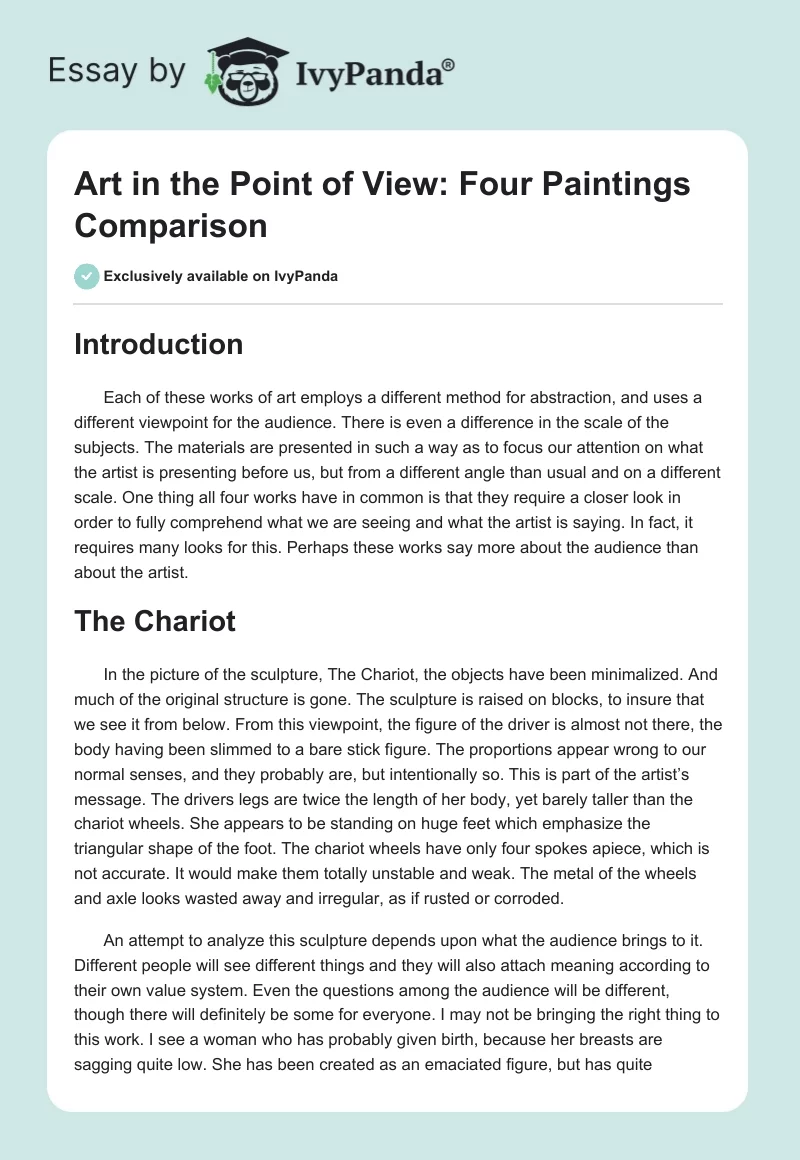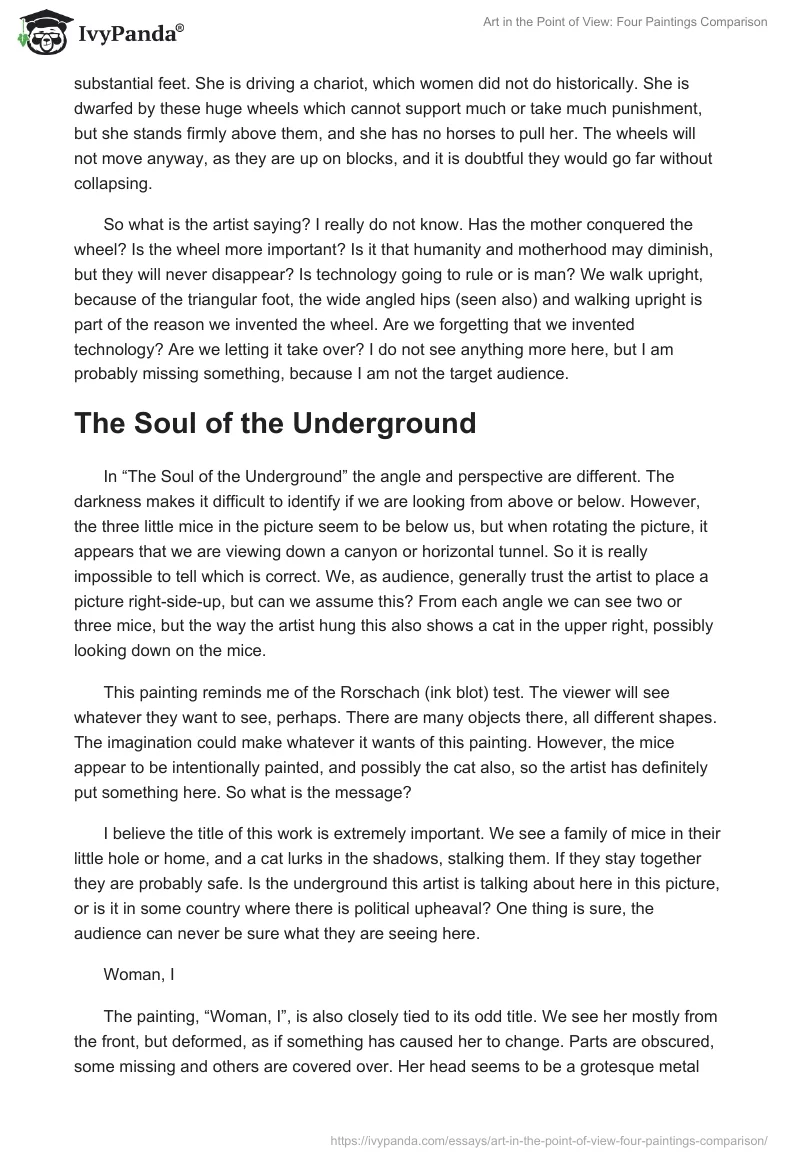Introduction
Each of these works of art employs a different method for abstraction, and uses a different viewpoint for the audience. There is even a difference in the scale of the subjects. The materials are presented in such a way as to focus our attention on what the artist is presenting before us, but from a different angle than usual and on a different scale. One thing all four works have in common is that they require a closer look in order to fully comprehend what we are seeing and what the artist is saying. In fact, it requires many looks for this. Perhaps these works say more about the audience than about the artist.
The Chariot
In the picture of the sculpture, The Chariot, the objects have been minimalized. And much of the original structure is gone. The sculpture is raised on blocks, to insure that we see it from below. From this viewpoint, the figure of the driver is almost not there, the body having been slimmed to a bare stick figure. The proportions appear wrong to our normal senses, and they probably are, but intentionally so. This is part of the artist’s message. The drivers legs are twice the length of her body, yet barely taller than the chariot wheels. She appears to be standing on huge feet which emphasize the triangular shape of the foot. The chariot wheels have only four spokes apiece, which is not accurate. It would make them totally unstable and weak. The metal of the wheels and axle looks wasted away and irregular, as if rusted or corroded.
An attempt to analyze this sculpture depends upon what the audience brings to it. Different people will see different things and they will also attach meaning according to their own value system. Even the questions among the audience will be different, though there will definitely be some for everyone. I may not be bringing the right thing to this work. I see a woman who has probably given birth, because her breasts are sagging quite low. She has been created as an emaciated figure, but has quite substantial feet. She is driving a chariot, which women did not do historically. She is dwarfed by these huge wheels which cannot support much or take much punishment, but she stands firmly above them, and she has no horses to pull her. The wheels will not move anyway, as they are up on blocks, and it is doubtful they would go far without collapsing.
So what is the artist saying? I really do not know. Has the mother conquered the wheel? Is the wheel more important? Is it that humanity and motherhood may diminish, but they will never disappear? Is technology going to rule or is man? We walk upright, because of the triangular foot, the wide angled hips (seen also) and walking upright is part of the reason we invented the wheel. Are we forgetting that we invented technology? Are we letting it take over? I do not see anything more here, but I am probably missing something, because I am not the target audience.
The Soul of the Underground
In “The Soul of the Underground” the angle and perspective are different. The darkness makes it difficult to identify if we are looking from above or below. However, the three little mice in the picture seem to be below us, but when rotating the picture, it appears that we are viewing down a canyon or horizontal tunnel. So it is really impossible to tell which is correct. We, as audience, generally trust the artist to place a picture right-side-up, but can we assume this? From each angle we can see two or three mice, but the way the artist hung this also shows a cat in the upper right, possibly looking down on the mice.
This painting reminds me of the Rorschach (ink blot) test. The viewer will see whatever they want to see, perhaps. There are many objects there, all different shapes. The imagination could make whatever it wants of this painting. However, the mice appear to be intentionally painted, and possibly the cat also, so the artist has definitely put something here. So what is the message?
I believe the title of this work is extremely important. We see a family of mice in their little hole or home, and a cat lurks in the shadows, stalking them. If they stay together they are probably safe. Is the underground this artist is talking about here in this picture, or is it in some country where there is political upheaval? One thing is sure, the audience can never be sure what they are seeing here.
Woman, I
The painting, “Woman, I”, is also closely tied to its odd title. We see her mostly from the front, but deformed, as if something has caused her to change. Parts are obscured, some missing and others are covered over. Her head seems to be a grotesque metal mask. We can see little of what is behind her, just a jumbled mass. Her body appears to have been segmented and stuck back together, inexpertly. Her breasts appear to be enclosed in a metal brassiere. The arm on the left side does not appear to be hers. Perhaps there is a man behind her. If so, his head is either hidden or missing. We assume this woman is sitting from the posture of her body, but we cannot tell upon what she is sitting. Her eyes are empty black circles and her mouth is a very odd grin. The figure is slightly larger than life sized.
The most prominent portion of this painting is the torso and head of this woman. So we ask what this could mean. The title seem familiar in some way, maybe a deformation of Asimov’s “I, Robot”? Is this another statement about technology? Is woman eclipsing man and also being replaced by machinery? Is this a statement about our culture? Are we losing what is human? Is this the woman of the future?
The Bed
The last painting, “The Bed”, is seen from above, flat, with no means of judging its size. The bottom half appears to be a well worn handmade quilt of muted desert colors, very earthy. The perspective changes in the top half. The edges appear to be frayed and worn, as if a hole were worn in it. The artist has managed to change the perspective once again. What we are looking down on appears to be a scene which should be viewed horizontally. However, in order to see it this way, we have to eliminate the rest of the bed.
The scene is impressionistic in style, and we cannot really tell what is there, but it appears to be a structure, probably man made. There is something that appears to be water, maybe a dock and what looks like a sailing vessel. Some of the shapes in this part of the picture seem to be created, as if fashioned by hand, and the only thing which appears natural is the blue water. The whole thing looks like maybe the quilt was hung on the wall, and then a hole is worn through it and the wall behind it (if there is one).
So how are we to interpret this? Maybe we are not supposed to at all. Maybe it is just a fantasy? Of all the works of art, I like this one the best, even though I probably miss the artist’s message entirely. The only real message I see here is of permanence and impermanence. The fabric is worn away, and the hole shows us something more permanent that is also a bit deformed. Perhaps by the action of the water. One most interesting point is that the object in the foreground could be a dock or a causeway which extends from the edge of the fabric to the other scene. One edge seems to be a bit of blanket which is not worn away.
The only interpretation I can bring to this work is that the artist is showing us his dreams. Maybe that is the importance of the bed. It is one place where we can always find dreams. It can be a doorway into another world entirely, an escape. So it is the dreams which are important and hot their reality. It is not important to realize our dreams but rather to simply have them.
Conclusions
All of these works are somewhat difficult to interpret, though not difficult to enjoy. I think that this is the essence of all art. Visual arts are expected to create a reaction in the audience, and possibly to be enjoyed. Even those works which produce strong negative emotions can be enjoyed. We experience a moment of understanding which is inexpressible with visual art, poetry and music. This is probably the reason the artists keep creating their art, in order to express the otherwise inexpressible. Therefore, we all bring something different to it and take something different from it.
We can see that these works are enticing us to look differently at ordinary objects. However, the artists, while they have different reasons for creating their works, and different things to say. What they have in common is that the artists are all showing us what they see, what is important to them and what it means to them. However, they are leaving the interpretation to the audience, since they really cannot control that. They control the perspective, the content, the style, the color and the other physical aspects of the work. The audience controls how the work is received and the impact. Yes, an astute artist can control some of the impact, mostly by knowing his or her audience. However, some of the audience will eventually be not part of the one the artist had in mind, so the reaction, interpretation and impact will change. However, for a true work of art, there will be communication, questions, interpretation, reaction and impact, regardless of the audience or the time. We still react and enjoy works from centuries past. It is expected that this will be so for many works far into the future. For me, the longest lasting impressions will be of “The Bed”, though I will certainly remember the others. Did I get the right message? Yes, of course, because the message is partly created by me. Did I get what the artist mean? Maybe some of it, but probably not all. Does it matter? No.


